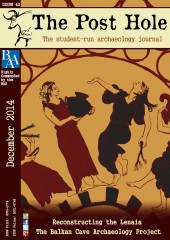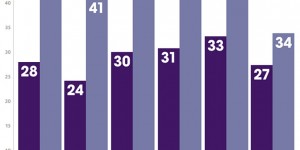A shift in the interest of archaeological interpretations from socio-economic aspects of life, to concerns about social and ideological spheres has substantially elevated the natural environment from a passive recipient of human activities to an active part of human-environment interactions (Ingold 1993, Tilley 1994). From the early 1990s onwards, phenomenological approaches started to affect archaeological interpretations and made the landscape a key factor in our understanding of human affairs in a given landscape setting; the landscape seems to "embrace" any human action (Ingold 1993; 2000). Man is no longer the centre of archaeological interpretation. The world in total forms the human and is being formed by him. The landscape becomes part of a social dimension of humans (Ingold 1993; 2000, David and Thomas 2008, Tilley 1994). These ideas have begun to find ground among archaeologists dealing with the uses and users of caves too (e.g. Bergvisk 2012, Heydari 2007, Mlekuz 2011).
Aside from being a part of the landscape and the natural environment, the cave is a closed space with specific limits, which have distinct characteristics and are governed by specific rules (Bogli 1978). The interior of the cave is another form of enclosed landscape, with which humans interact with in an attempt to exploit it. The absolute, or almost absolute darkness, that prevails inside caves, the intense humidity, the stable temperature, the drop flow, the speleo-themes and the unusual flora and fauna seem to affect how a person perceives the space of the cave (Trimmis 2013). The cave acquires a transcendent meaning as something outside and beyond the ordinary world that surrounds us (Ustinova 2009).
This research project aims to be a valuable addition to the current debate concerning the lifeways and the landscape exploitation during the Neolithic period in the Balkans (e.g. Boric 2005, Budja 2011, Kotsakis 2006, Porčić 2012, Souvatzi 2008). Over the last decade or so, there have been significant discussions in Balkan archaeology regarding the complexity of identity construction of the individuals and groups in the Neolithic (e.g. Bailey 2000, Boric 2005, Chapman 2000, Chapman & Gaydarska 2011). However, there have only been a few attempts (e.g. Forenbaher et al. 2010, Mlekuž 2011, Trantalidou 2012) to investigate the lifeways of Neolithic people who used caves. The reasons for this silence on Neolithic cave users may lie in the fact that Neolithic archaeologists do not focus on caves, instead favouring the abundant open-air sites. Also, activities inside caves are not considered significantly different from human activities at open-air sites (Bergvisk 2012). Nevertheless, when the social role of caves has been studied, not only is there a difference concerning the range of activities that unfold in these different loci, but also that the same activities differed between caves and open-air settlements (Bonsall 1997, Sampson 2007). Trantalidou (2012) investigated these differences in the context of the Neolithic Balkans; connecting pastoral practices with the use of caves and separating those practices with the manipulation of the livestock in the open-air settlements. Having analysed finds from thirty five caves in Greece, Albania and Bulgaria it has been observed that the majority of the caves had been used by pastoral groups who seemed to have visited the cave every time from the same open air settlements. Mlekuz (2009) connected caves with herding practices and discussed the difference of the livestock manipulation in a cave environment. Mlekuz seems to agree with Trantalidou on the pastoral use of caves. However, he believes that caves have been used on the Adriatic coast as permanent barns as well. On the other hand, researchers such as Forenbaher (2010) and Tomkins (2009) highlight the ritual use of caves on the Adriatic and the Aegean, and support that caves played a significant role for the people’s ideological expressions. This project builds on these research strengths, and aims to investigate in more detail caves as part of the landscape on an equal footing with open-air sites, in order to reach a more holistic comprehension of the Neolithic way of being.
To-date, the social role of caves has been investigated in the context of Maya societies in Central America (Brady 2012). This work combines environmental data from various caves with the spatial organization and artefact densities, in order to investigate the practices that Mayan societies followed to allow them to exploit the cave environment. In the European context, some authors in Scandinavia (Bergvisk 2012) and in the Karstic region of Slovenia on the North-eastern coast of Adriatic (Mlekuz 2011) have provided more insightful discussions about the specificity of cave users. Thus, they believe that caves were used for certain reasons, either to host economical activities (such as herding) or for ritual-cult places. These researchers have attempted to study caves within a landscape perspective and in correlation to the wider social context. However, neither of these case studies took into account the importance of cave’s micro-environmental characteristics.
The current research in the Balkans seems to suggest that caves had a special role in Neolithic societies (Mlekuz 2011, Sampson 2008, Trantalidou 2012) and they do not explicitly research the caves in relation to this role (Mihevc 2013; Sampson 2007; Tomkins 2009). As far as the social sketch of people who used and exploited the caves is concerned, so far only sporadic and small- scale attempts have been made (Mlekuz 2011, Trantalidou 2012).
The Balkan Cave Archaeology Project
a) Exploring the Neolithic cave use strategies in Western Balkans. |
The current research project adopts a pioneering methodology in the field of spatial analysis in the cave environment. The intention is to move from a classic geographical interpretation of the spatial data to a geosophical approach, which encapsulates the geographical information in a more phenomenological way of thinking (Gillings 2011; 2012, Rennell 2012). In order to undertake the transition from a quantitative approach, which correlates the geographical data with artefact clusters, to a qualitative methodology, we are taking into account the environmental values, the sounds and people’s active perspectives. In order to achieve this goal, the project is collecting data not only on the spatial data of artefacts found in these caves, but also the spatial data about caves’ micro-environmental characteristics. These characteristics include; light zones, humidity and temperature areas, the caves’ speleothem decoration, soundscapes, including cave fauna and water-dripping and even smells. In order to measure the light quality, SAMPO photometers are used and for humidity and temperature hygrometers and thermometers suitable for cave environments are used. As far as sounds are concerned, a high sensitivity Digital Audio Workstation is used. Moreover, regarding the data of the deposits’ smells a pioneering pilot method that requires the use of Medeleine Camera, a unique device for smell recording, will be used. All the sampling spots, the locations of the archaeological finds and the 3D cave model will be recorded with the Heeb’s paperless mapping method (http://paperless.bheeb.ch) (Trimmis 2013). Through the micro-spatial analysis and spatial distribution of these parameters in a particular intra-site area (vertical and horizontal), we will be able to outline which areas inside caves share common characteristics. Furthermore, it will be possible to investigate if the areas with the same characteristics are the areas where specific clusters of artefacts present high densities.
The research was divided into three main stages. In the first stage, data was collected (archaeological, geological and spatial) from 64 excavated caves in the wider area of the Dinaric Alps and Northern Pindos and was then added to a geo-referenced database, using ArcGIS and SpeleoBase software, in order to answer the following research questions: (i) which areas of caves were used and for what purpose (ii) what micro-environmental zone in each case shows a greater intensity of use (light zone at the entrance, twilight zone, dark zone). In the second phase, the ecological data from six already excavated caves were investigated and correlated with the archaeological data. The main aim was to investigate if the artefacts’ densities and clusters correlate with specifically defined areas of the cave environments. Data from the caves of Sarakeinos and Koromilia in Greece, Tren and Konipsol in Albania, Grapceva and Pupicina in Croatia were used (Fig. 1). The vertical correlation between the artefacts and ecofacts data distribution was achieved by using raster map algebra as an analytic tool in the ArcGIS software.
In the third phase, the cave site of Spila near the town Perast in the Kotor Bay of southern Montenegro, will be excavated in order to collect high resolution data about the Neolithic use of this cave. The cave is almost located in an area between other sites in the eastern Adriatic to the north, and the Pindus range and then the Ionian Sea to the south. This particular region has not provided any recently excavated sites with high quality detail. From the 1968 excavations of Spila we know that several Neolithic layers are well represented in the site’s stratigraphy (Markovic 1985). Spila has the total length of 62m and has the maximal width of 15 m. The cave’s entrance is on a slope at 600 m alt. facing the gulf of Kotor and it presents all three micro-environmental zones (light, twilight and dark zone). During the 1968 excavation, two trenches were opened, one near the entrance and the second in the middle of the cave near to the south-western wall. On the basis of pottery typology, the stratigraphic sequence spans the Middle to the Late Neolithic, from around the mid-sixth to the end of the fifth millennium. There are no radiocarbon dates from this cave. Pottery shards and animal bones were collected during the first excavations. The importance of Spila’s location above the Kotor gulf, observing a natural harbour on the crossroads of the western Balkans creates a very important case study in order to study the role of caves in the Neolithic Balkans.
b) The online Cave Archaeology database
The research project aims to study the use of caves in the Neolithic Balkans as well as gather information about the use of caves in the wider area. For this purpose a webpage has been created where information on the archaeology of the caves in the Balkans is collated (www.balkancavearcheo.org). Primarily the webpage includes information regarding the first scale of the project. Gradually however, an attempt will be made to include data concerning other caves with Neolithic deposits or even caves which have occupation dates in other periods. As this webpage aspires to be a communication forum where researchers can study the archaeology of the Balkan caves, anyone who holds information about a certain cave can include it on the site through a special form that is available to download. Additional information on caves, which has already been published, can be introduced.
This online database serves three main purposes. Firstly it aims to provide researchers with information, bibliographic sources and data. Secondly it intends to promote the research whilst constituting a publication forum for results and bibliographies. Finally it aspires to be a means of communication where researchers will be able to find posts advertising meetings and conferences, research announcements and field working reports through the online blog. The success of this endeavour depends on the acceptance of the researchers. However, we hope that a communication and participation forum will be created and as a result the role of the caves in the societies of each era will be better and further understood.
Preliminary results and final thoughts
The Balkan Cave Archaeology project will have completed a year of action by the end of 2014 during which the informative data from 11 caves have been added to the webpage. Preliminary results (drawn mainly by the study of data from the caves of Koromilia, Kastoria, Greece, Saracenos Boetia, Greece and Spil Himare in Albania) showcase that two theories on the financial dimension of the cave in the Neolithic seem to apply. More specifically Sampson’s theory (2007) that people used the caves based on the characteristics of their environment seems to be confirmed. Thus the dark, humid cold caves or parts of a cave were mainly used for storage whereas, the more spacious caves with better lighting and ventilation were used to house animals, craft production or temporarily shelter for pastorals, farmers, hunters and fishermen. Trantalidou’s (2010) theory about the space organisation in the interior of the cave also appears to be confirmed. As such the interior of the caves presents additional constructions including postholes, dry-stone walls, cobblestones or clay floors, which form spaces of particular activities.
These theories are still being examined and tested in other cave sites. Nonetheless, the new findings from the study concerning the distribution of the findings in the interior of the caves and their correlation with the micro-environmental characteristics indicate that people did not regard the caves as just one enclosed space but as a space presenting a variety of characteristics, each of them being appropriate for a different use.
However, the continuation of the research leads to new questions that need to be examined. Do the users of the caves form a distinct group of people among the wider society of open-air settlements? Are there common or different practices in the exploitation of the caves during the Neolithic in the Balkans? Finally, what is the role of the caves in the development and formation of the European Neolithic? Despite the scope for further research, what is easily understood is that the caves play a significant and particular role in the societies of that time. This role needs to be taken into account by the researchers when studying the complicated dynamic societies of the Neolithic in the Balkans and beyond.
Acknowledgements
The Balkan Cave Archaeology Project is supported by the British Cave Research Association (BCRA) and the Balkan Speleological Union (BSU). I would like to especially thank BCRA for the entire support to me as a new researcher. I will also thank Konstantina Kalogirou and Evelina Arazou for their tireless help on the English corrections for this article.
Bibliography
- Bailey, D. (2000). Balkan Prehistory. London: Routledge.
- Brady, J. (2012). ed. Heart of Earth. Studies in Maya Ritual Cave Use. Austin: Association for Mexican Cave Studies.
- Bergsvik, K.A. and Skeates,R. (eds) (2011).. Caves in Context. The Cultural Significance in Caves and Rockshelters in Europe. Oxford: Oxbow.
- Bonsal, C. and Tolan Smith, C. (eds) (1997). The Human Use of Caves. Oxford: Archaeopress.
- Boric, D. (2005). Deconstructing essentialisms: unsettling frontiers of the Mesolithic- Neolithic Balkans. inBailey, D., Whittle, A. and Cummings, V (eds.) 2005 (Un)settling the Neolithic. Oxford: Oxbow.
- Bogli, A. (1978). Karsthydrographie und physisch spelaologie. Berlin.
- Budja, M. (2011).’ In search of past identities’. Documenta Praehistorica 38, 46-59
- Chapman, J. (2000). Fragmentation in archaeology : people, places and broken objects in the prehistory of south-eastern Europe. London; New York: Routledge
- Chapman, J. and Gaydarska, B. (2011). ‘Can we reconcile individualisation with relational personhood? A case study from the Early Neolithic?’. Documenta Praehistorica 38, 21-44.
- David, B. and Thomas, J (eds). (2008). Handbook of Landscape Archaeology. World Archaeological Congress Research Handbooks in Archaeology. Walnut Creek: Left Coast Press.
- Forenbaher and Miracle (2005). ‘Neolithic and Bronze-Age herders of Pupićina Cave, Croatia’, Journal of Field Archaeology, 30(3), 255-281
- Forenbaher, S., Kaiser, T. and Frame, S. (2010). ‘Adriatic Neolithic Mortuary Ritual at Grapčeva Cave, Croatia’, Journal of field Archaeology 35 (4), 337- 354.
- Gillings, M. (2011). 'Chorography, Phenomenology and the Antiquarian Tradition', Cambridge Archaeological Journal 21(1),53 - 64.
- Gillings, M. (2012). 'Landscape Phenomenology, GIS and the Role of Affordance', Journal of Archaeological Method and Theory 19(4),601- 611.
- Heydari, S. (2007). ‘The impact of geology and geomorphology on cave and rockeshelter archaeological site formation, preservation and distribution in the Zagros mountains of Iran’, Geoarchaeology International Journal, 22(6), 653- 659.
- Ingold, T. (1993). ‘The temporality of the landscape’, World Archaeology 25(2), 152-174
- Ingold, T. (2000). The Perception of the Environment: Essays on Livelihood, Dwelling and Skill. London: Routledge
- Marković Č. (1985). Neolit Crne Gore. Beograd: University of Belgrade
- Mlekuz, D. (2009). ‘The materiality of dung: the manipulation of dung in Neolithic Mediterranean caves’, Documenta Praehistorica 36, 219-225
- Mlekuz, D. (2011). ‘What bodies can do? Bodies and caves in the Karst Neolithic’, Documenta Praehistorica 38, 1-11
- Porčić, M. (2012). ‘Effects of Residential Mobility on the Ratio of Average House Floor Area to Average Household Size: Implications for Demographic Reconstructions in Archaeology’, Cross-Cultural Research, 46(1), 72-86.
- Rennell, R. (2012). ‘Landscape, Experience and GIS: Exploring the Potential for Methodological Dialogue’, Journal of Archaeological Method and Theory 19(4), 510-525.
- Sampson, A. (2007). Προϊστορική Αρχαιολογία της Μεσογείου. Athens: Kardamitsa
- Sampson, A. (2008). The Cave of the Cyclops : Mesolithic and Neolithic networks in the Northern Aegean, Greece. Philadelphia: INSTAP Academic Press.
- Souvatzi, S. (2008). A Social Archaeology of Households in Neolithic Greece: An Anthropological Approach. Cambridge and New York: Cambridge University Press
- Tilley, C. (1994). A Phenomenology of Landscape: Places, Paths and Monuments. Oxford: Oxford University Press.
- Tomkins, P. (2009). ‘Domesticity By Default. Ritual, Ritualization and Cave-Use in the Neolithic Aegean’. Oxford Journal of Archaeology 28, 125- 153.
- Trantalidou, K., Belegrinoy, E. and Andreasen, N. (2010). ‘Pastoral societies in southern Balkan peninsula: the evidence from caves occupied during the Neolithic and Chalcolithic era’, ANODOS, studies of ancient world 10, 321- 334.
- Trimmis, K. P. (2013). GIS and Archaeological Cave Sites. The Case Study of Kastoria, Greece. MA thesis. [online]. Available at: http://invenio.lib.auth.gr/record/134029/files/GRI-2014-12059.pdf Accessed: 15 October 2014.
- Ustinova, Y. (2009). ‘Cave experiences and Ancient Greek oracles’, Time and Mind 2 (3), 265- 286.


 a.jpg)





